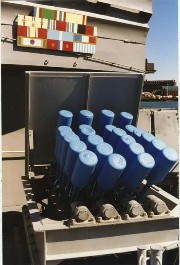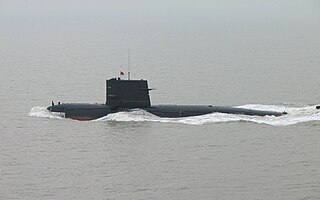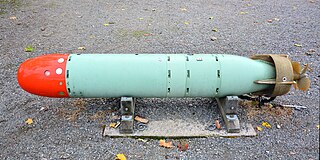
Sonar is a technique that uses sound propagation to navigate, measure distances (ranging), communicate with or detect objects on or under the surface of the water, such as other vessels.

A modern torpedo is an underwater ranged weapon launched above or below the water surface, self-propelled towards a target, and with an explosive warhead designed to detonate either on contact with or in proximity to the target. Historically, such a device was called an automotive, automobile, locomotive, or fish torpedo; colloquially a fish. The term torpedo originally applied to a variety of devices, most of which would today be called mines. From about 1900, torpedo has been used strictly to designate a self-propelled underwater explosive device.
The Mark 24 Tigerfish was a heavyweight acoustic homing torpedo used by the Royal Navy (RN) during the 1980s and 90s. Conceptual development dates to the mid-1950s, and formally started in 1959 with a target introduction date in 1969. A lengthy development process led to a greatly reduced performance requirement, including the removal of anti-surface capabilities. The first prototype "Tiger Fish" examples were delivered in 1967.
The Spearfish torpedo is the heavy torpedo used by the submarines of the Royal Navy. It can be guided by wire or by autonomous active or passive sonar, and provides both anti-submarine warfare (ASW) and anti-surface warfare (ASuW) capability. Spearfish development began in the 1970s, with production starting in 1988, and deployment in 1992. By 2004, the new weapon had completely replaced the older Tigerfish torpedo. It is one of the most advanced torpedoes in the world.

Type 53 is the common name for a family of 53 cm torpedoes manufactured in Russia, starting with the 53-27 torpedo and continuing to the modern UGST (Fizik-1), which is being replaced by the Futlyar.

A sonobuoy is a relatively small buoy – typically 13 cm (5 in) diameter and 91 cm (3 ft) long – expendable sonar system that is dropped/ejected from aircraft or ships conducting anti-submarine warfare or underwater acoustic research.

An anti-submarine weapon (ASW) is any one of a number of devices that are intended to act against a submarine and its crew, to destroy (sink) the vessel or reduce its capability as a weapon of war. In its simplest sense, an anti-submarine weapon is usually a projectile, missile or bomb that is optimized to destroy submarines.

The MU90 Impact is a Franco-Italian advanced lightweight anti-submarine torpedo of the third generation developed for the French and Italian navies, as well as for export. It is designed to outperform the United States-built Mark 54 in and was developed in a special MU90 Hard Kill version for anti-torpedo defence. It is built by EuroTorp, a consortium of French and Italian companies.
The G7es (T5) "Zaunkönig" ("wren") was a passive acoustic torpedo employed by German U-boats during World War II. It was called the GNAT by the British.

The Mark 24 mine is an air-dropped anti-submarine (ASW) acoustic torpedo developed by the United States during World War II; it was called a mine to conceal its capabilities. The torpedo entered service with the Allies in March 1943; the United States Navy (USN) used it until 1948. Approximately 4,000 were produced. Of the 340 deployed during the war, 204 were fired, sinking 37 and damaging 18 Axis submarines.

A towed array sonar is a system of hydrophones towed behind a submarine or a surface ship on a cable. Trailing the hydrophones behind the vessel, on a cable that can be kilometers long, keeps the array's sensors away from the ship's own noise sources, greatly improving its signal-to-noise ratio, and hence the effectiveness of detecting and tracking faint contacts, such as quiet, low noise-emitting submarine threats, or seismic signals.

Anti-submarine warfare is a branch of underwater warfare that uses surface warships, aircraft, submarines, or other platforms, to find, track, and deter, damage, or destroy enemy submarines. Such operations are typically carried out to protect friendly shipping and coastal facilities from submarine attacks and to overcome blockades.

The Type 039 submarine is a class of diesel-electric submarines of the People's Liberation Army Navy. The class is the first diesel-electric submarine to be fully developed within China and also the first Chinese diesel-electric submarine to use the teardrop hull shape.
The Yu-3 (鱼-3) is a Chinese acoustic homing torpedo designed to be fired from submarines against surface targets. It entered service with the Chinese Navy in 1984. Several sources state that it may be a copy of the Soviet SET-65E, although this seems unlikely as development began in 1965 after the Sino-Soviet split. It is therefore probably the first indigenously developed torpedo in China.
Yu-5 (鱼-5) torpedo is the first wire-guided torpedo developed by China. It is an ASW torpedo designed for conventional diesel-electric submarines. It is often erroneously referred as the Chinese copy of Soviet TEST-71 torpedo, which is incorrect as the Soviet torpedo was developed in 1971 and its successor TEST-71MKE was developed in 1977, at the worst time of Sino-Soviet split. With Yu-5 entering Chinese service in 1989, it was simply impossible to acquire any technologies of Soviet TEST-71 torpedo, which was not purchased by China until 1993, four years after the Yu-5 torpedo had already entered service. The Yu-5 is not a product of indigenous development and is based largely upon previous Soviet and American designs, with much of the propulsion system being derived from the American Mark 46 lightweight torpedo.
Several British 21-inch (533 mm) torpedoes have been used by the Royal Navy since their first development just before the First World War.
Torped 62 is a torpedo used by the Swedish Navy, possibly to be in use until the mid-2040s.
The Type 035 submarine is a class of diesel-electric submarines of the People's Liberation Army Navy. The Type 035 is a heavily improved redesign of the older Type 033 submarines, which were built in China from 1962 to 1984.

The Torped 45 is a lightweight torpedo intended for ASW and surface targets, providing multiple-target active/passive homing combined with wire guidance. It is designed and manufactured by Saab Dynamics. It was designed for the Swedish Navy, based on the experience gathered from the well proven 43-series of torpedoes.
The Torped 47 or SLWT is a new lightweight torpedo intended for ASW and surface targets, providing multiple-target active/passive homing combined with wire guidance. It is designed and manufactured by Saab Dynamics as a replacement for the Torped 45.










